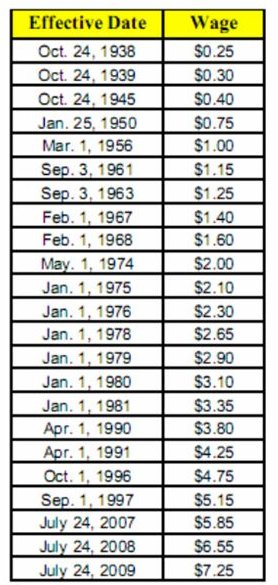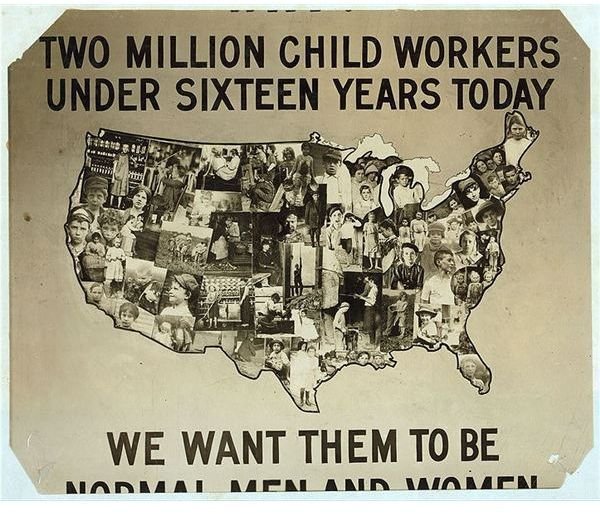Recalling the History of Minimum Wage Laws: How They Changed Working Conditions in America
How the History of Minimum Wage Laws All Began
Revisiting the history of minimum wage laws will give us a deeper perception of what these laws really stand for. Massachusetts was one of the early American regions where local colonial rules required every family household to work, including the children. This was particularly true if the family unit belonged to the poorer sector of the colony. Yet in 1912, it adopted the first minimum wage standard law based on an old Australian 1890s minimum wage edict.
During the age of industrialization, the textile industry was one of the most prominent users of the American labor force, which was divided into gender and age. The men worked as farmhands and laborers, usually in cotton plantations that supplied raw materials for the textile factories. Adolescent females and children manned the mills to operate the power looms and sewing machines. Children typically earned 25 cents a week that went directly to the family coffers.
Birth of the Labor Unions
Labor unions began to organize as working conditions became harsh. The stiffer the competition faced by the textile industry in both local and international markets, the harsher the impact it created in the working conditions of the women and children workers. The introduction of synthetic fabrics placed the cotton industry in a precarious balance as profits plummeted and wage cuts were implemented. This drove the workers to hold labor strikes that fought for the rights of women and children who were overworked and underpaid.
Whenever and wherever labor unions created trouble, the textile factory simply closed shop and transferred to a new location where work was badly needed and where labor could even be cheaper. If this was not possible, new workers were hired, comprising mostly immigrants coming from Italy, France, Ireland, and Canada. This all the more intensified union strikes and spurred bloody riots but eventually goaded the Massachusetts government to adopt minimum wage laws.

A Cry for Help
It was only during the 1936 presidential elections that the American labor problems attracted nationwide attention. An often-told story was that of a young female factory worker who attempted to hand a note to President Franklin Roosevelt, who was then campaigning for reelection. Although the girl’s attempt was thwarted by one of the closed-in aides, President Roosevelt asked the aide to get the note. The famous note contained a cry for help addressed to the US president, which related how their wages were cut down from $11 a week, down to $4 to $6 per week.
After being reelected back into office, President Roosevelt waged a long and hard battle for the enactment of a minimum wage standards law, which was stirred by the young girl’s note. Aside from the strong opposition coming from different business sectors, the history of American laws have it on record that in 1923, a Supreme Court in Washington D.C. made a ruling against the implementation of minimum wage standards.
Support from Patriotic Americans
Nevertheless, President Roosevelt gained the support from a group of businessmen who manifested their support by committing to pay their workers $12 to $15 minimum weekly work pay for maximum 35 to 40 hours per week. In addition, they vowed not to resort to child labor nor employ anyone under 16 years old. Patriotic American consumers joined the cause by boycotting products of manufacturers who did not have the “badge of honor;” this badge identified products manufactured by businesses who supported the minimum wage movement and the ban against child labor.
In the meantime, the Supreme Court continued to strike out appeals for the implementation of laws recognizing standards for wages on the premise that they hindered the worker’s right to set his own price for his services. However, a glimmer of hope started to shine through when, in 1937, the Supreme Court finally ruled in favor of implementing minimum wage standards for women.
Read on to the next page for the continuation of the minimum wage law history and its victory.
Victory of the Minimum Wage Law Movement

President Franklin Roosevelt, along with millions of American workers and supporters, had emerged victorious as the Fair Labor Standards Act (FLSA) of 1938 was finally instituted. The very first wage-floor passed by the FLSA of 1938 was at 25 cents per hour, and a cap of 44 hours per week was likewise implemented. The most significant change contributed by the minimum wage laws was the ban and restrictions against child labor.
Since the first standard in 1938, the history of the minimum wage laws have seen more than twenty amendments and twenty-two wage hikes, including the wage increase that took effect last July 24, 2009. This brought the current minimum wage to $7.25 per hour.
The image on your left is a chart of all the US wage hikes that transpired from 1938 through July 2009. (Kindly click on the image to get a larger view.)
Information about Minimum Wage Law that Every Employer Should Know
The following pieces of information are significant guidelines pertaining to the implementation of the minimum wage laws:
-
Every US state, city, and county is free to institute their own standards of minimum wage higher than the standard set by the federal government. In cases of conflict between the standard set by the lower unit and that of the federal government, the standard with higher minimum wage will prevail.
-
All businesses whose total annual sales are equivalent to $500,000 or more are required to abide by the minimum wage enacted last July, 2009.
-
All businesses regardless of annual sales but whose employees perform activities known as “interstate commerce” like, but not limited to, mailing, calling, and shipping or receiving goods on behalf of the company are required to pay said employees according to the minimum wage standard.
-
Any employer qualified under the law to pay the minimum wage standard, but which is subsequently found by the US Department of Labor to be circumventing or avoiding the payment of the current minimum wage, shall be required to pay back-wages to employees who were deprived of the benefit of the minimum wage salary.
-
Employers who will be hiring students on a full-time basis to perform work in any business engaged in service, retail, or higher education have to seek approval from the Department of Labor to pay salaries based at only 85% of the stipulated minimum wage. In addition, employers shall not require students to report for work for more than 24 hours a week while school is still in session. However, work hours may extend up to 40 hours per week if the work is rendered during school-term breaks.
-
Employers hiring youth workers who are below 20 years of age shall pay said youth workers no less than $4.25 per hour during the first 90 days of employment. Once a youth worker works beyond the 90-day probationary or turns twenty years old during the 90-day period, the youth worker who assumes the age of majority shall then be entitled to the federal minimum wage of $7.25.
-
Employers hiring persons with disabilities may apply or seek approval from the Department of Labor to pay only sub-minimum wage as compensation for the disabled employee based on grounds of impaired productivity.
-
Employees who receive regular tips amounting to more than $30 per month are required to receive $2.13 as direct wages from their employers. However, if the base rate of $2.13 plus the actual tips received by the employee is equivalent to salaries computed at the minimum wage rate, the employee is entitled to receive all of his earned tips.
-
Workers rendering voluntary services or as interns purely to acquire work expertise or skills should be properly informed beforehand that any remuneration bestowed to them is not required by law to fall under the standards of the minimum wage set by the federal government.
As we reflect on the history of minimum wage laws and what they are today, the changes can be summed up by how workers are now collectively referred to as human resources instead of a “labor force.” Since 1938, community and business sectors have been giving value to the workers’ contributions to society as humans, and not as “beasts of burden.”
Reference Materials and Image Credit Section
Reference Materials:
- US Department of Labor - Maximum Struggle for a Minimum Wage Fair Labor Standards Act of 1938: - https://www.dol.gov/oasam/programs/history/flsa1938.htm
- Cliffor F. Thies, The First Minimum Wage Laws - Cato Journal —https://www.cato.org/pubs/journal/cj10n3/cj10n3-7.pdf
- Minimum Wage Law Chart by CCH — https://www.cch.com/press/news/2007/MinimumWageChart.pdf
Image Credits:
